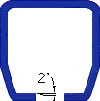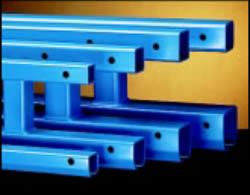|
|
|
|
|
|
|
|
|
Rigid
Runways Provide for Superior
Positioning of Loads |
|
|
|
|
|
|
|
|
|
|
 |
|
The
2° taper of the running
flange helps to center the
trolley in the track for smooth,
effortless movement of trolleys
and end trucks. |
|
|
Work Station Bridge Cranes
are installed so that the
runways are rigid. They do not move laterally or
longitudinally. In addition, the floating end trucks with
horizontal wheels prevent binding. The combination of
these design features results in unmatched ease of
positioning and ease of movement. The bridge travels
smoothly down the runways, and movement is unvarying
along the way, no matter where a load is positioned on
the bridge. This allows superior load positioning.
Another advantage of rigid runways is that runways
double as stringers between support columns. This
eliminates the need for expensive intermediate support
stringers, and it lowers overall installation cost.
|
|
|
|
|
|
|
|
|
|
|
|
|
|
|
|
 |
|
|
|
|
|
|
|
|
| What
is meant by Rated Capacity? |
|
|
|
|
|
|
|
|
|
|
|
|
|
The
rated capacity is the live load that can be lifted by
the crane system. The design load for the crane system
is based on the rated capacity plus 15% for the weight
of the hoist and trolley (capacity x 1.15) and an additional
25% for impact (capacity x 1.25) for a total design of
capacity x 1.4 (Note, 25% impact factor is good for
hoist speeds up to 50 f.p.m.). For example, a 1000 lb.
crane allows you to pick up a 1000 lbs. load, provided
the hoist weights 150 lbs. or less and the hoist speed is
less than 50 feet per minute. |
TRUSSED
STEEL TRACK: |
|
|
|
|
|
|
|
|
Permits
longer spans which allows more flexibility
in crane layout. |
|
|
|
|
|
|
|
|
|
The trussed series uses the
plain steel track profile but is
enhanced for longer spans via a built-up truss design. This
design increases the span, which decreases the need for
frequent hangers. Model numbers start with: GLCS-FS
for spans up to 20 feet, GLCSL-FS for spans up to 25
feet, and GLCSLX-FS for spans up to 30 feet.
Long spans translate into fewer runway support points,
less interference of work cell layout, longer bridge lengths,
and free standing capabilities... just another reason why
these Work Station Cranes are among the most versatile
to apply and easiest to install in the industry.
|
|
|
|
|
Design
load for deflection calculations is based on
the rated capacity plus 15% for the weight of the hoist
and trolley (capacity x 1.15). Under no conditions should
the crane be loaded beyond it rated capacity. Work
Station Cranes meet or exceed the ANSI B30.11
specifications for underhung bridge cranes. |
|
|
|
|
|
|
|
|
|
|
|
| |
|
|
|
|
|
|
|
|
|
|